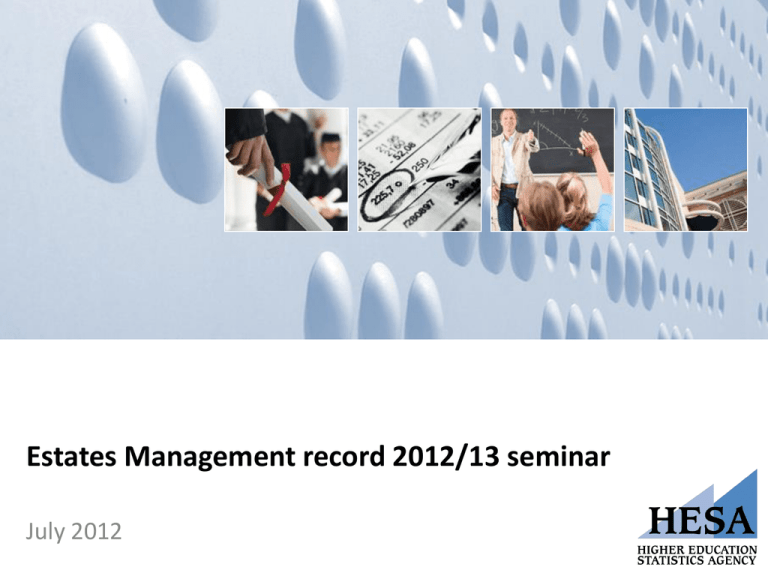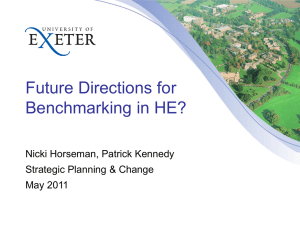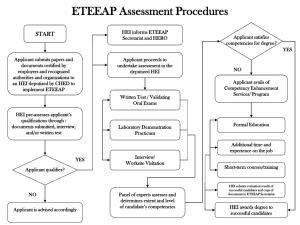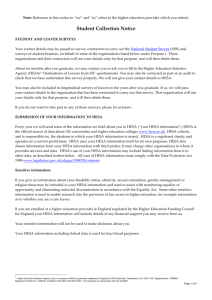EMR 2012/13 Presentation
advertisement

Estates Management record 2012/13 seminar July 2012 “the participation of universities in the wellestablished HESA Record Review process has recently brought about simplification of staff and estate management statistics.” David Willetts, 18 April 2012 Objectives • Introduce the Estates Management training manual • Cover changes to the record for 2012/13 • Highlight data quality issues in the existing EMS record • Provide an update on developments at HESA About the review • Commence in June 2011… • …involving estates sector bodies, funding body representatives, institutional representatives (with expertise covering a number of estates areas about which data is returned) and members of HESA staff • Proposals for change put to the sector received a high number of responses through the consultation • Responses were broadly supportive of the changes proposed Data items removed in their entirety – – – – – – FTE environmental staff Current cost of legislative compliance Method of costs apportionment Assessment of building condition Total facilities costs Carbon conversion factor for Use for renewable energy sources – Travel plan on web – Environmental policy on web – Biodiversity policy on web So, in terms of data cells to be entered… • There were around 328 data items • Now there are 556 – 426 EMR data items – 130 Health and Safety data items The consequences of all these changes are: • Ratios need updating • Groupings need reviewing and what is included in each • New referencing system needed • Changes to the web form • New web form for Health and Safety • New record name needed Ratios • Ratios are produced by HESA • Asked during consultation to indicate any new ratios that would be useful (some responses received) • Need to be ready for mid-2013 New referencing system • • • • HESA inherited a referencing system from IPD Outgrown as a consequence of expansion over the years No space for further expansion Consultation responses demonstrated support for a new system (within reason) • Happy to ditch the ‘D’ references e.g. D01 = HEI income, D02 – HEI expenditure… • …but would like to retain the specific data requirement label e.g. C01 = Total HEI, C13 = Total non-residential New referencing system and new presentation • We know that the enormous HTML Data Definitions document was not ideal • Review presented an opportunity to look at bringing EMR in line with other recordsStill working on short names • Mapping document will need to be produced • Example of how it will look included in June 30 release Changes to the web form • Web form needs updating to reflect changes to content • Any additional calculations will be included in the web form where formulas can be agreed • Override will apply to any new calculations New web form for Health and Safety • Separate web form needs to be produced for Health and Safety • Some auto-calculations from previously inputted answers • Generally numbers will be entered but needs to allow for some text responses Coverage • All data items continue to be collected with respect to a reporting period • 1 August 2012 to 31 July 2013 • Unless explicitly otherwise stated in the data definitions, all data should be reported as the latest position at the end of the reporting period Commercial space • Previously inclusion/exclusion of commercial space was inconsistent between HEIs • Historical position untenable moving forward • The new record aims to address matters of consistency whilst being sympathetic to the difficulties of extracting such data from the Estates record Mandatory data items • Mandatory data items have not increased significantly… • …however new ones do exist to support scope 3 carbon emissions data reporting Null versus zero • A critical issue that has been identified in the last two years worth of EMS data submitted to HESA • Institutions must ensure they are reporting zeros and nulls for the right data items • This issue has a significant impact on your data and the onwards use made of it Area data Number of sites • This data item used to only count sites which were non-residential… • …however the item now collects the number of total sites for the whole estate Number of buildings • The data item has not fundamentally changed as part of the new record • Ensuring consistent application of the criteria is important when determining whether a building is included in the count Grounds area • Grounds are is for the total grounds of the HEI • Original consultation proposed removal of ‘Grounds water’ from this data item • ‘Grounds water’ is still included as a separate category Gross internal area (GIA) • GIA still measured in the same way i.e. measured to the internal face of the perimeter walls of each floor (including internal walls and perimeters etc) • Exclude derelict space, accommodation on NHS sites, structures attached to the outside of building, and commercial space that does not meet the definition for inclusion • Commercial space that is included should be recorded in the new separate category within GIA Net Internal Area (NIA) • Net Internal Area is still returned using either NIA RICS or NIA room area • Uplift still applied to room area calculations • No change to underlying definitions re. what are balance areas • Any commercial space reported should be done so in the new separate category within NIA • Difficulty of categorising NIA Specialist academic area • Records the total amount of academic floor space that can be classified as ‘specialist’ • Definition of ‘space that cannot easily be used for other non-specialist academic activities’ • Remember this data is a subset of the total NIA figure!!!!! Frequency rate • Changes to how frequency rates are calculated have been made • Instead of ‘9 to 5’ the core working week is determined locally by the institution • Commercial space should not be included as relates to teaching space only Building condition assessment • Condition definitions remain the same • Full survey should be carried out regularly (every five years)…. • …and should be done so by an appropriately qualified and experienced professional Student / Staff Counts Student data • Provided by HESA – Liaise with your Student record contact for a preview of the data • Added automatically to the webform – Data can be overridden • All students regardless of intensity of study – Excluding franchise or distance learning • Includes all FE students – Must be based on campus – Only added automatically if returned to HESA – Can add to figure using override if not returned to HESA • Split by categories – Teaching – Research Page 45 Student headcount A. B. C. D. Page 45 Not included – course commenced after 1 December Included – present on 1 December Not included – course finished before 1 December Included – present on 1 December Student Full-time Equivalent (FTE) Page 45 Spans the entire reporting period 0.8 FTE 1.0 FTE 0.5 FTE 1.0 FTE A. B. C. D. 0.8 FTE 1.0 FTE 0.5 FTE 1.0 FTE Total HEI = 3.3 FTE Staff data Page 47 • Not provided by HESA – Closely liaise with your department responsible for staff data • HESA cannot provide this through the Staff record – Difference in population and granularity • Approximations of data should be avoided – Proxies may sometimes have to be used • Split by several categories – Staff with split FTE between teaching and research should have their FTE apportioned accordingly Sense check against figures provided in the Staff record Staff categories Page 47 Category FTE Description Teaching total Teaching staff including academic support staff Research total Research staff including academic support staff Teaching total + research total Totals combined Support offices Support staff predominately based in offices Support other Support staff predominately based outside of offices Other non-residential Other staff who are not academic or central support Total non-residential Totals combined Residential Staff allocated to student residences Environmental staff No longer collected separately Calculating FTE Page 48 Full-time equivalent = Benchmark Full-time equivalent = Benchmark Contracted hours Contracted hours Full-time equivalent Contract fulfilled Proportionate full-time equivalent Property management staff Facilities management staff FTE Estate management Staff FTE Project management staff FTE Property management staffing total FTE page 49 • Include all staff FTE carrying out related work, whether they to the estates department or not • Exclude staff not directly employed by the HEI • Exclude staff associated solely with commercial space Finance Finance data items HEI Income HEI Expenditure Capital expenditure Total property costs Rateable value Rates paid Insurance premiums and contributions Insurance replacement value Net service charge/miscellaneous PFI/PPP costs Energy costs Water and sewerage costs Repair and maintenance costs Cleaning costs Internally-incurred management costs Externally-incurred management costs Method of costs apportionment Total facilities costs Security costs Porterage costs Central post room and internal distribution services costs HESA Finance Statistics Return Collected December each year. Table 2: Table 1: Consolidated income and expenditure Tale 4: Consolidated cash flow statement Table 6b: Income analysed by source Consolidated statement of recognised gains and losses Table 5a&b: Research grants and contracts Table 3: Consolidated balance sheet Table 6a: Tuition fees and education contracts Table 7: Table 8: Expenditure by activity Capital expenditure Data direct from HESA HEI income All data items FSR table 6b HEI expenditure All data items FSR table 7 Capital expenditure Buildings Total nonresidential FSR table 8 sub-heads 1a and 2a New for 2012/13: Previously HEI expenditure Residential was not provided. In future this will use the ‘Total residences and catering operations’ total from the FSR. Liaise with Finance record contact to ensure common approach to these data items Total property costs Page 56 Simplified for 2012/13 – detailed non-residential splits removed. Total non-residential, residential and Total HEI autocalculate where all component parts are returned in EMS (as listed in your training manual). Where all parts components are not known the data can be overwritten, however this will not be a true reflection of Total property costs. Total property costs 2011/12 • Currently Residential total should be entered by the HEI. • DQ check to be added for 2011/12 to ensure that Total HEI is greater than or equal to the sum of Total non-residential and residential. • Some anomalies have been found for 2010/11. Insurance replacement value Page 57 Item has presented some confusion in the past. IRV = Cost to rebuild not total value for which insured. Rebuild value is not the same as current market value or insured value. www.bcis.co.uk It is expected that this data item will be updated at least every 3 years Energy costs page 58 • New energy components added for 2012/13 – Biomass – Onsite photovoltaic (solar panels) • Include – Climate Change Levy (CCL) • Exclude – Direct costs of EU ETS and CRC schemes – Commercial spaces • Some renewable energy sources will have no costs if owned and managed by the HEI, but where the electricity is purchased from a third party that runs it, or where fuel is bought (e.g. biomass pellets) those costs should be entered. Repairs and maintenance costschanges for 2012/13 page 59 • New name for 2012/13 – previously Maintenance costs • Data item rationalised for 2012/13 – removed splits for buildings planned and reactive • Following sector request during consultation the splits for grounds and playing fields will remain Repairs and maintenance costs – data consistency • Plan for 2012/13 was to use HESA Finance data • Finance collects repairs and maintenance in Table 7. • However, Finance collects estates admin staff costs whilst these are separated out in Estates • Instead Finance data will be used as cross-check to Estates data in DQ checking • It is expected that the Repairs and maintenance costs returned in the Estates data will be lower than the costs returned in the Finance data. Cleaning costs – common queries Qu: Where should window cleaning be included? Ans: Internal Qu: How should costs be attributed to residential/nonresidential? Ans: Should tally to the split returned in area Qu: Should cleaning administration costs be included here? Ans: No, these costs should be counted under facilities management costs within internally-incurred/externallymanaged property management costs. Internally-incurred and externally-provided property management costs Page 61 • Simplified for 2012/13 – splits between estates, facilities and management costs removed • Amalgamated totals to be returned Security and Porterage costs Security costs • The costs of security contractors and employed staff and regular system maintenance. Both items require splits by non-res, res and total HEI. Porterage costs • The costs of porterage contractors and employed staff. • Duties may include: small office moves, events, room and exams set-up and reception cover. Energy Energy data items Energy consumption Fuel used in HEI-owned vehicles Water consumption Energy emissions Scope 1 and 2 carbon emissions (energy use) Use of renewable energy sources Purchase of renewable energy through green tariffs Carbon savings will Energy generated on site by CHP be part of the Renewable energy generated on or off site figure returned under Scope 1 and Use of renewable energy 2 Carbon emissions D72f Carbon conversion factor for D72e (energy use). Waste mass Hazardous waste Water supply ‘grey water’ and rain water Water supply borehole extraction Volume of wastewater EU Emissions Trading Scheme Energy consumption Page 65 Currently collects: Oil Coal Gas Steam/hot water Electricity Other fuels From 2012/13 this is expanded to: Energy consumption • Required to return all energy types used by the HEI estate • Consumption per energy type is only required for the total HEI. Alongside this a total split for nonresidential and residential should be provided. Fuel used in HEI-owned vehicles Page 67 Separated out from Energy consumption from 2012/13. Figure in litres per fuel type Scope 1 & 2 carbon emissions (energy use) Page 72 From 12/13 HESA will be carrying out DEFRA conversion factors centrally to Ensure consistency and comparability Reduce burden on HEIs Any issues with this? Please let liaison@hesa.ac.uk know. ‘Green tariff’ electricity is only considered to be zero carbon rated where the ROCs have been retained. Waste mass page 71 • New categories for 2012/13 – Composting (on or off site) – Anaerobic digestion (on or off site) – Landfill • Do not include: – Waste taken in by the institution for processing – Waste attributable to the operation of commercial space Hazardous waste • New for 2012/13 • To include combined Total HEI tonnage of Asbestos Chemicals Electrical and electronic equipment Fluorescent light tubes and energy-saving light bulbs Healthcare/clinical Lead acid batteries Oils Pesticides Refrigerators containing ozone-depleting substances Solvents • Expected that majority of HEIs will have some waste Scope 3 The Scopes Scope 1 Scope 2 Scope 3 Direct GHG emissions from sources owned or controlled by the reporting institution e.g. boilers and furnaces GHG emissions from the generation of electricity purchased by the institution Indirect emissions produced by an institution’s activities but occurring from sources not owned or managed by the institution Why include Scope 3? • HEFCE consulted on HE strategy for carbon reduction • Support for tool to measure emissions – EM record provides this • Collection of this data will – Provide information on managing scope 3 emissions – Demonstrate HEI efforts to reduce carbon Scope 3 data items Business travel Staff commuting Student commuting Waste Method used to calculate scope 3 carbon emissions from waste Water supply Wastewater treatment Supply chain (procurement) Scope 3 business travel • Includes travel undertaken by staff and students • Excludes travel paid for by a third party • Conversions to be carried out by HEIs. Air travel Rail travel Vehicles Company cars Leased cars Public transport (bus/tube/tram) Taxis Coaches Ferries Defining Scope 3 business travel Commuter travel Page 76 Definition: • Travel to and from home address to the HEI • For students use term-time address How to collect: • Travel survey – – – – Distance travelled Mode of transport Include all travel over the course of a week Randomly selected commuters - sample size – enough for confidence e.g. population 10,000 need to survey 370 Benefits of collecting Scope 3 travel? How to collect the data? ‘Measuring scope 3 carbon emissions – transport: A guide to good practice.’ http://www.hefce.ac.uk/pubs/year/2012/201202/#d.e n.68754 Conversions To convert the data it is needed to know 1. The mode of travel 2. Activity data (fuel consumption or distance travelled) 3. Appropriate conversion factor (Defra/DECC) Activity data Conversion factor Scope 3 carbon emissions Waste Page 78 Total GHG emissions in production and treatment of waste. Recognised that HEI approaches to waste and recycling varies Calculated through Defra conversion factors Method used also captured Water Page 80 Water supply • Residential/non-residential/total HEI split tonnes GHG emissions Waste water • Total HEI tonnes GHG emissions To be converted by HESA using Water consumption data Supply chain (procurement) Page 81 • Supply chain = purchasing of goods and services and the emissions this generates. • Collection of data will allow benchmarking and provide insights on ways to reduce emissions. Reporting tool • Annual returns database to Regional Purchasing Consortia to create full emissions report for all HEIs in England • Data can then be used to populate Estates return • This includes 75 Defra carbon points Supply chain sections Business services Information and communication technology Paper products Waste and water Other manufactured products Medical and precision instruments Manufactured fuels, chemicals and gases Other procurement Food and catering Unclassified Policy % modal split for staff and students % single occupancy car journey Single occupancy car journeys % car share % bus % train % cycle % walk % motorbike % other Page 85 Should not include business travel Should not include travel to or from the students home (holiday) address The term-time post code of every student is collected through the HESA student record Consider the join-up between the results of the survey and the institutional travel plan It is anticipated this information will be collected via staff and student surveys Surveys should be conducted on an annual basis Continuing data items Number of car parking spaces Figure Number of cycle spaces Figure Page 86 Environmental management system Environmental reporting Fairtrade accreditation Yes Yes Yes No No No Health & Safety Health and safety Page 89 • Health and safety data is an existing reporting requirement • Prior to 2012/13 this return is made to Universities Safety and Health Association (USHA) In line with the sector policy of reducing data collection burden on institutions, from 2012/13 the data will be returned to HESA • Data collected according to the guidance and definitions specified by the Health and Safety Executive within Reporting of Injuries, Diseases and Dangerous Occurrences Regulations 1995 (RIDDOR) www.hse.gov.uk/riddor • Liaise with the existing department/member of staff who is responsible for returning this information • Excludes commercial space across all data items Incidents involving injury Fatalities Specified major injuries • Staff • Students • Other • Staff • Students • Other Arising out of or in connection with… • • • • Non-employee • Students hospital treatment • Others for reportable injuries Other injuries involving more than 7 days’ incapacitation • Staff • Students • Other Page 89 Fatalities Specified major injuries or conditions Injuries to non-employees requiring hospital treatment Injuries involving staff in more than seven days absence from work – Change (wef 6 April 2012) the overthree-day reporting requirement for people at work changes to overseven-days starting the day after the accident • Split by Staff, Students and Other • Totals automatically generated from required fields Dangerous Occurrences • Part 1 General (21 categories) – – – – – – – – – Lifting machinery, etc. Pressure systems Freight containers Overhead electrical lines Electrical short circuit Explosives Biological agents Collapse of scaffolding Fairground equipment Page 89 2005 2006 2007 2008 2009 2010 44 37 41 63 79 51 Total reportable Total reportable Number of RIDDOR reportable dangerous occurrences Defined in Part 1 General of schedule 1 Number of other dangerous occurrences All other dangerous occurrences including accidents which did not result in injury, e.g. near misses www.legislation.gov.uk/uksi/1995/3163/schedule/2/made Occupational injuries 1. 2. 3. 4. 5. 6. 7. 8. 9. 10. 11. 12. 13. 14. 15. Page 89 Contact with moving machinery or material being machines Hit by a moving, flying or falling object Hit by a moving vehicle Hit something fixed or stationary Injured whilst handling, lifting or carrying Slipped, tripped or fell on the same level Fell from a height Totals must be split Trapped by something collapsing Drowned or asphyxiated Exposed to, or in contact with a harmful substance Staff Exposed to fire Students Other Contact with electricity or an electrical discharge Injured by an animal Physically assaulted by a person Another kind of accident www.legislation.gov.uk/uksi/1995/3163/schedule/3/made Occupational diseases Page 89 • Reportable under RIDDOR • Excludes occupational diseases reported by those occupying commercial space • Record total number of instances of occupational diseases • Not split by staff, student and other www.legislation.gov.uk/uksi/1995/3163/schedule/3/made Fire safety Fire safety Page 90 • Fire safety data is an existing reporting requirement • Prior to 2012/13 this return is made to Universities Safety and Health Association (USHA) • Liaise with the existing department/member of staff who is responsible for returning this information • Splits by ‘Total non-residential’ and ‘Total residential’ Consider the relative coverage of both the Estates Management record and that of the health and safety information. Health and safety or fire incidents may occur on space/buildings not otherwise included in the Estates Management record but will still need to be recorded. Types of fire Major fire An incident involving smoke, heat and flames causing property damage to multiple building fixtures of fittings Definition of a fire Minor fire An incident involving smoke, heat and flames causing only localised damage to equipment or property Near miss An incident involving only smoke, without flames, which may or may not cause damage Categories • Cooking • Malicious • Electrical • Naked flame • Hot works / contractor activity Nature of fire Nature of fire Nature of fire Nature of fire Nature of fire • Laboratory activity • Smoking • Car fire • Not able to determine • Other Nature of fire Nature of fire Nature of fire Nature of fire Nature of fire Other data items Item Split Directly exposed to fire/smoke Students Number of external fires Total HEI Number of internal fires that did not sound the fire alarm Total HEI Number of injuries as a result of fire Staff Other Total Nonresidential Residential Total HEI Number of malicious alarms Total Nonresidential Residential Total HEI Number of other false activations Total Nonresidential Residential Total HEI Total number of fire alarm activations Total Nonresidential Residential Total HEI Number of automatic detectors Total Nonresidential Residential Total HEI Fire and rescue services attendance Total Nonresidential Residential Total HEI Type of injury Categories Guidance • External fires – Examples: Bin fires, skip fires, BBQ’s and bonfires • Internal fires that do not result in fire alarm activations – These are incidents where a fire occurs and is extinguished without the fire alarm system being activated • Number of injuries as a result of fire – Any injury requiring medical attention Guidance • Number of malicious alarms – A deliberate improper actuation of a fire alarm system • Number of other false activations – Includes accidental manual call point activation, alarms raised with good intent, equipment defects and environmental conditions • Total number of fire alarm activations – Calculated from the sum total number of malicious alarms, other false activations and total number of fires minus the number of internal fires that did not sound the fire alarm Guidance • Number of automatic detectors – Requirement under BS:5839 and UK Fire Safety legislation • Fire and rescue service attendance – Record total number of times the fire and rescue services attend emergency calls to University owned and managed property for fires and false alarms www.usha.org.uk Other data • Number of bed spaces – Auto generated from ‘EMR Number of bed spaces Residential’ – Total number of student bed spaces under direct management of the HEI – Excludes commercial space – Ratios • Total number of UG and PG students at the HEI – – – – Auto generated from ‘EMR Student headcount total HEI’ Total number of student Excludes distance learning and franchise Ratios Onwards use of EMS data Estates Management publication produced by HESA 2010/11 data released 26 April 2012 Free data table includes: • Grounds and buildings • Water and energy usage • Waste management • Transport and other environmental measurements Available at www.hesa.ac.uk/pubs/ems Developments at HESA • Aardvark regeneration project • User accounts project • Heidi developments HESA-Estates@JISCMAIL.AC.UK HESA information and discussion forum for HESA Estates. These lists are used to circulate email news alerts from HESA regarding data requirements, coding manuals and validation kit releases. Want to join? email liaison@hesa.ac.uk or visit www.jiscmail.ac.uk Data collection and submission The Institutional Liaison team are there to help with all aspects of the return from local collection of data items through to final submission and sign-off. Contact the team liaison@hesa.ac.uk 01242 211144 Training support If you require additional training help, including bespoke visits to your institution, get in touch with the training department… w: www.hesa.ac.uk/training e: training@hesa.ac.uk t: 01242 211472 Follow us on Twitter: @HESATraining









